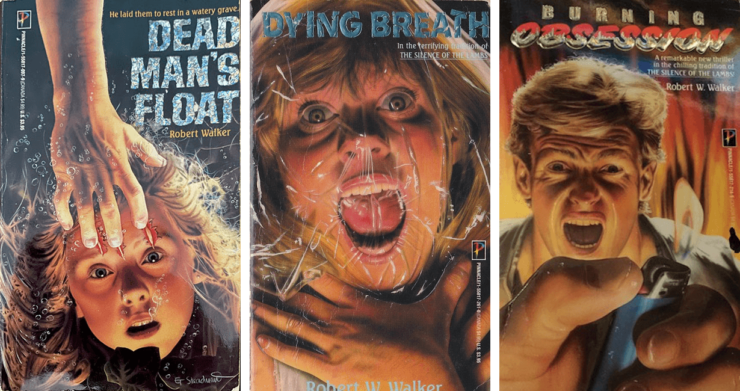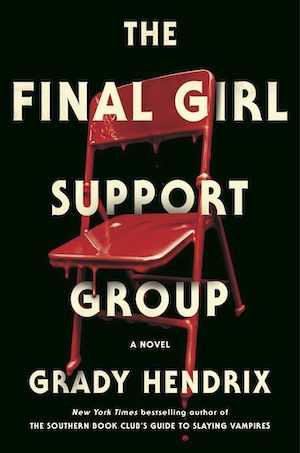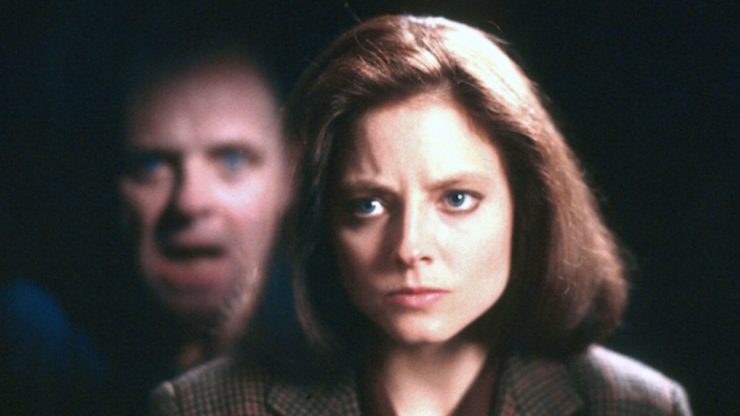Silence of the Lambs changed everything. Thomas Harris’ book became a blockbuster in 1988 and then its movie adaptation swept the Oscars in 1991… and suddenly Hannibal Lecter was a joke on The Simpsons and everyone was talking about chianti and fava beans. Lecter was a maroon-eyed, six-fingered fancypants who humblebragged that he drew his photorealistic sketch of the Duomo from memory the first time he meets Clarice Starling. Essentially, he has ESP and mind control, turning people into serial killers or getting them to commit suicide simply by talking to them, capable of identifying and pricing perfumes, purses, and shoes within seconds, like the world’s greatest contestant on The Price Is Right. After Lecter, a drifter with a knife seemed downright basic.
So serial killers acquired superpowers. Patricia Cornwell’s Temple Gault is a super-hacker karate expert who likes military uniforms. Rex Miller’s “Chaingang” Bunkowski is a 400-pound ninja who can turn invisible by regulating his breathing and heart rate, is immune to poison ivy, and travels everywhere with adorable puppies tucked into his pockets. Their death traps and super plots became so ornate a Bond villain would blush. How could we catch these supervillains who lurked in our bushes and our sheds? How could we stop these hyper-intelligent, enormously talented, essentially superpowered lunatics who wanted to kill our women? We needed superheroes.
Fortunately, Thomas Harris provided those, too.
In his first serial killer book, 1981’s Red Dragon, Harris introduced us to FBI criminal profiler Will Graham, a dude so dedicated to catching serial killers that he gets all up inside their heads until he thinks like them, causing him to become moody, aggressive, and drink a lot. The kind of hero who sacrifices personal happiness to save total strangers, Will Graham turned out to be a very appealing look for a new type of protagonist and he spawned a whole swarm of “mindhunting” FBI criminal profilers.
It helped that the FBI’s Behavioral Science Unit was not only real, but actively churning out criminal profiles for police departments at a rapid clip (600 in 1986 alone). Law enforcement loves criminal profiling, ranking it as “operationally useful” a massive majority of the time. The public loves it too, with television shows like Criminal Minds, Hannibal, and Mindhunter glorifying profilers. This level of customer satisfaction is strange because criminal profiling turns out to be singularly useless in real life, with its successes usually represented by a handful of much-loved anecdotes, and its failures documented in study after study. The short version: criminal profiling leads to arrests about 2% of the time, and in many cases trained profilers perform about as well as people off the street when trying to identify future criminal behavior based on psychological data.
But authors and moviemakers didn’t care! They needed Batman-Profilers to catch their Joker-Serial Killers. Profilers were dedicated men (or mostly men) with strong convictions who went to small towns where evil had been done. They examined the scene of the crime, years of training allowing them to see evidence invisible to the untrained eye, trying to stop these godless monsters before they struck again. They had very little in common with actual FBI profilers who spent most of their time in offices typing reports, but they did have a lot in common with 17th-century witch hunters. Like profilers, witch hunters were men on a mission who arrived in small towns armed with nothing more than extensive training and faith in their infallibility. They visited crime scenes and conducted interrogations to discover the identities of secret evildoers who lurked undetected in the midst of their neighbors, trying to stop them before they struck again. Both serial killers and witches were viewed as nothing more than pure, Satanic evil—so anything you did to capture and/or kill them was totally justified.

Criminal profilers don’t come any more dedicated, or any more ridiculous, than Dr. Dean Grant. Medical examiner for the city of Chicago, he has flashing eyes and few friends. Haunted and dedicated, his concern for victims often spilled over into “a madman’s deliberate obsession.” As he says, with a totally straight face, “The dead talk to me.” When we meet him in Robert W. Walker’s Dead Man’s Float he’s standing over the body of 12-year-old Laura Baines, found floating facedown in an Indiana lake in the middle of winter. The local cops seem happy to write her off as a suicide, but Dr. Grant notes her neatly folded clothing on the shore and decides that a 12-year-old would never fold her clothes so neatly. This is murder!
Disbelievers surround Dr. Grant. The police mock his homicide theory. Jackie, his wife, cries, “Christ, Dean, so what? Another floater. There’s always another floater, always has been, always will be!” But Dr. Grant has the power of his convictions, his faith in science, and his almost fanatical dedication to crimefighting. As he crouches over Laura’s neatly-folded clothing he whispers, “Laura…little girl…you’re priority one…priority one…”
As usual, Dr. Grant is right! There is a drowner at work. A girl possessed by the spirit of her failed Catholic priest brother (who loves the feel of his sister’s underwear and hose against his skin) drowns “weak” people to cleanse them of sin. She learned it from her mother, who trained her other siblings in the same art, and now there’s a network of watery serial killers across America that Dr. Grant… never investigates further. Probably because he has to take on an obese deli butcher who faints at the sight of blood and communes with the astral spirit of King Solomon when he gets high huffing the breath of his victims whom he traps inside plastic bags and asphyxiates over the course of several hours (Dying Breath). There’s also a maniac who hates eyes and is armed with a laser blowtorch on a campaign to murder his mother’s disembodied spirit that flits from woman to woman (Burning Obsession). Or he has to travel to Orlando where two Bob Seger-loving brothers form a “man-and-dwarf murder team” that scalps its victims because the dwarf brother, Van, needs a toupée to cover his bald head to please Satan (who loves hair), who will then turn him into a wizard. When his brother tries to stop the scalpings, Van lashes him with a bullwhip woven from human hair.
But Dr. Grant is just a normal, albeit driven, medical examiner, you cry! How does he stop this rogue’s gallery of weirdos? With science! As his lab assistant says in her “nasally but sensual voice”:
“Anything’s possible in forensic medicine.”
Buy the Book


The Final Girl Support Group
Probably because author Robert Walker just makes it all up. Profiler fiction revels in the details of forensic investigation, establishing its authority with chemistry talk and microscopes despite the fact that most forensic science is utterly unreliable. In profiler fiction the setpieces aren’t chases and gunplay, but autopsies and fingerprinting. The Dr. Grant books deconstruct those articles of faith by making its forensic science deeply ridiculous. Most of us think of Seconal as a powerful sedative, but are you a doctor? Dr. Dean Grant knows that Seconal will glow in the dark wherever it touches moisture and he often sprays it on the ground to detect blood. He uses infrared photography not to detect heat but to find footsteps left in puddles. He uses a “small nuclear reactor” to create a killer’s “hair chart” which is apparently as unique as fingerprints.
Dr. Dean Grant can scrape condensed human breath off plastic bags, and if you breathe on a slide he’ll put it in “The Tracer,” which uses laser beams to turn it back into a liquid that he can analyze. Bourbon is a chemical, napalm is a poisonous gas, and in Dying Breath they gently brush one victim’s clothing hoping to dislodge random fiber or hair samples, a pretty standard procedure. What isn’t standard is that they upend a bottle of baby powder all over the clothes first.
Profiler fiction establishes its authority by deploying scientific details, but Walker’s books make it all up as they go along, from the science to the plots, hoping to bluff the reader. Masking its ridiculous twists and phony forensics with tough cop attitude, they wind up coming across with all the authority of Dragnet taking on LSD. In doing so, they deconstruct the entire genre, showing that all that talk about dedication and science is a fancy facade that hides the blithe mountain of BS lurking at the core of the profiler genre.
(NOTE: If you want to track down one of Dr. Dean Grant’s silly adventures, Razor’s Edge is definitely the best, followed by Dying Breath, Dead Man’s Float, and finally, Burning Obsession. A laser blowtorch has nothing on a whip-wielding, Satan-fueled would-be wizard.)
Grady Hendrix is the award-winning, New York Times bestselling author of The Southern Book Club’s Guide to Slaying Vampires, along with a bunch of other books and movies. His new novel is The Final Girl Support Group (out July 13) and you can find more dumb facts about him over at gradyhendrix.com.










